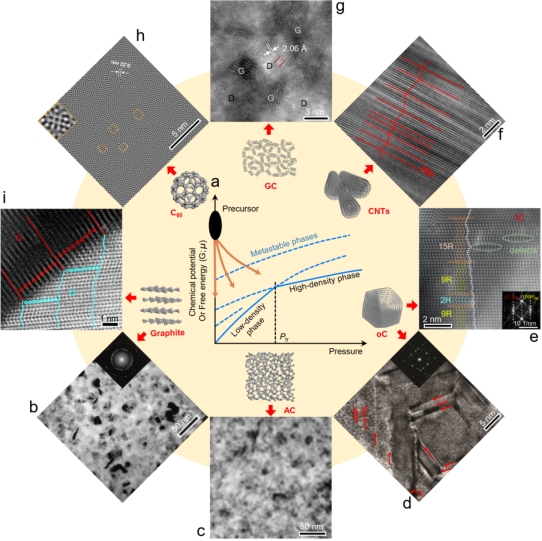Diamond, as a unique material, is not only highly favored in the jewelry industry for its dazzling brilliance, but also holds a critical position in scientific and technological realms due to its exceptional physicochemical properties. However, its inherent brittleness and limited toughness have long constrained broader technological applications. Recently, Academician Tian Yongjun's Team at YSU State Key Laboratory of Metastable Materials Science and Technology published a review article titled Microstructure Engineering in Diamond-Based Materials in the prestigious journal Nature Materials. The paper systematically summarizes the latest research advances in enhancing the properties of diamond and its derivative materials through microstructure engineering.
The review elaborates in detail on the implementation strategies of diamond microstructure engineering: By selecting diverse carbon precursor materials and leveraging the core technology of high-pressure and high-temperature (HPHT) synthesis, the team achieved precise design and control of complex microstructures. This approach successfully produced a series of innovative materials, including nanotwinned diamond, hierarchically structured diamond composites, graphite-diamond hybrid material Gradia, and amorphous diamond (See Figure 1). These advancements not only significantly enhanced diamond’s hardness and toughness, but also endowed it with multifunctionality. The review further delves into strategies for overcoming traditional limitations of diamond through microstructure engineering: By precisely regulating diamond grain and twin structures, the team harnessed the Hall-Petch effect and quantum confinement effect to significantly enhance diamond hardness - exemplified by nanotwinned diamond achieving a Vickers hardness of 175–203 GPa, far surpassing conventional single-crystal diamond. Simultaneously, the design of specialized interfacial architectures and composite-phase configurations successfully resolved the long-standing trade-off between hardness and toughness in traditional diamond materials. Additionally, low-density carbon allotropes (e.g., graphite, fullerenes, glassy carbon) can be transformed under HPHT conditions into diamond-based materials with unique microstructures and tailored functionalities, offering expansive possibilities for the design and development of multifunctional diamond materials. The review also highlights a series of emerging phenomena discovered in diamond-based materials, including the evolutionary behavior of incoherent twin boundaries, room-temperature self-healing capabilities, and tunable electrical and optical properties. These findings not only deepen the understanding of the fundamental science of diamond materials, but also unlock novel pathways for their applications in electronics, optics, and other related fields. The review also outlines future research priorities for diamond-based materials, including the fabrication of high-quality nanotwinned diamonds with diameters exceeding 3 mm to meet the application requirements of diamond anvil cell (DAC) devices; the reduction of twin boundary thickness to near-theoretical limits (approximately 0.618 nanometers) to further enhance diamond hardness; and the exploration of application potential of diamond's self-healing phenomenon in ceramic bonding technology.

Figure 1. Synthesis of diamond-based materials with diverse microstructures from various low-density carbon precursors under high-pressure and high-temperature (HPHT) conditions.
The review article was independently completed by YSU State Key Laboratory of Metastable Materials Science and Technology, with Nie Anmin, Zhao Zhisheng, Xu Bo, and Tian Yongjun serving as corresponding authors. The project is funded by the National Natural Science Foundation of China (52288102, 52090022), the Natural Science Foundation of Hebei Province (E2024203054, E2022203109), and other programs.